Sean O’Keefe: NASA’s indispensable reformerby Taylor Dinerman
|
| NASA desperately needed a reformer and in Sean O’Keefe it got one. |
Goldin’s management of the International Space Station and space shuttle programs were little better. In spite of the partnership with the Russians, which was supposed to save money, the costs of the station kept expanding with no end in sight. As for the shuttle, a culture grew up around it that, according to the Columbia Accident Investigation Board (CAIB), contributed directly to the February 2003 disaster.
NASA desperately needed a reformer and in Sean O’Keefe it got one. He started small. For example, the accounting system at the agency was dysfunctional: some elements of it even dated back to 1916 when the old NACA had been formed. O’Keefe forced the individual centers to give up their independent systems and made them accountable to him and to the Congress as never before.
O’Keefe mercilessly forced ISS managers to cut one element after another until the costs had been brought roughly in correspondence with projections. In doing so he got an expensive and painful education in what was wrong with the way the Office of Space Flight did business. Along with the Space Flight boss, former astronaut Bill Readdy, he established a new “core complete” program that stood a good chance of having the station built and operational as a world-class science facility by 2007 or 2008. It even looked as if they were going to be able to afford some of the items that had been canceled, such as the Node 3 module and a new life support system to complement the current unstable Russian one.
The Columbia disaster not only killed seven brave astronauts, it destroyed the ISS construction schedule and budget. O’Keefe was quietly able to bring the international partners and the Congress into a process that revised the assembly plan and made it compatible with the new safety requirements recommended by the CAIB. When the shuttle returns to flight this spring, it will be due in large part to O’Keefe’s hard work and expert leadership.
Meanwhile, a small planning group worked closely with the White House on what was to become known as the Vision for Space Exploration, announced by President Bush in January 2004. Starting from the disgraceful fact that no human being has left Earth orbit since 1972 and the political reality that NASA’s budget will never be more than roughly one percent of America’s GDP, they put together a plan to return to the Moon and eventually go on to Mars. This plan should be, in their words “sustainable and affordable.”
| The space agency’s bureaucracy has been only partly reformed. The “One NASA” program, with its goal of getting the centers to work effectively with one another, has been sketchily implemented at best. |
The plan was dismissed by many of the President’s opponents as an election-year mirage. They claimed that NASA would never be able to accomplish these goals with the money available. In fact, since the plan will ground the shuttle fleet in 2010 or 2011 and the US will no longer pay the lions’ share of the ISS after about 2014, the Russian, Japanese, Europeans, and possibly the Chinese will either take responsibility for running it, or some way will be found to hand it off to private enterprise. The seven to eight billion dollars a year now devoted to these two programs will be freed up to pay for the new exploration systems.
This year NASA got a substantial increase in its budget, virtually the only non-security related part of the government to be so lucky. It earned this by proving, to the satisfaction of a skeptical Congress, that it had put its wasteful habits behind it. The Administrator should be proud of his accomplishments so far, but the job is only half-done.
The space agency’s bureaucracy has been only partly reformed. The “One NASA” program, with its goal of getting the centers to work effectively with one another, has been sketchily implemented at best. O’Keefe’s success at keeping the cost estimates realistic and honest—or at least not grossly out of line with reality—is by no means firmly established.
For the sake of its economic and technological competitiveness, America needs a visionary space program. NASA’s next leader should be someone who can, at the very least, match O’Keefe’s leadership skills and reforming passion.
